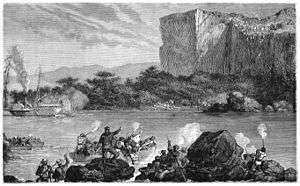Siege of Medina Fort
The Siege of Fort Medina took place in 1857 at Médine on the left bank of the Senegal River, in modern-day Mali, when the Toucouleur forces of Omar Saidou Tall unsuccessfully besieged native and French colonial troops under General Louis Faidherbe, governor of Senegal.
| Siege of Medina Fort | |||||
|---|---|---|---|---|---|
| Part of the French colonial wars | |||||
 Eugene Mage's view of the lifting of the siege of Fort Medina, from Voyage dans le Soudan occidental (1868) | |||||
| |||||
| Belligerents | |||||
|
| Toucouleur Empire | ||||
| Commanders and leaders | |||||
| Louis Faidherbe | Omar Saidou Tall | ||||
Origin
France at this time was struggling to create a West African empire to rival the holdings of its powerful neighbor Britain. In 1854, General Louis Faidherbe was appointed Governor of Senegal and soon began an expansion of French interests into the interior savannahs of what is now Senegal and Mali. The expansion began by going up the Senegal River and establishing a series of forts.[1] The army moved troops, cannon and other supplies by steamship where possible and overland where not.
In 1848, Omar Tall launched his jihad against neighboring Malinké regions. By 1855, his rapid expansion had led to several skirmishes with the French army. With the authorization of his ally, Khasso Queen Hawa Demba Diallo, Governor Faidherbe ordered a fort built at the Khasso town of Medina, not far from Kayes.
The siege
In April 1857, Omar Tall declared war against the Khasso kingdom, and marched on Fort Medina, their nearest outpost, with an army of between 15,000[2] and 20,000,[3] which included riflemen armed with French rifles. The fort at the time had about 7,000 inhabitants, with some French but mostly Khasso troops. Omar Tall laid siege to the fort and began a series of assaults that resulted in hundreds of casualties for the Toucouleur army. In the 97 days that followed, the defenders' food supplies soon ran low, and the fort was on the verge of surrendering when, in mid-July, Faidherbe arrived by steamboat with supplies and 500 reinforcements, breaking the siege.[2][4]
Consequences
Following the relief of Fort Medina, Faidherbe signed a treaty with the Omar Tall gaining concessions for the French down to the Niger River.[4]
Realizing the difficulties of attacking the well-equipped French, Omar Tall turned his attention to the neighboring Bambara Empire, conquering most of its territory including its capital of Ségou in 1861.[5] However, the French continued to expand their West African presence, conquering Ségou and the Toucouleur Empire less than thirty years after Omar Taal's death.
Present-day Medine
The Fort du Medine is open to the public. The Fort is located about 12 km east of Kayes on the "road to Bamako." There is also an old railroad station and European-style cemetery with graves from the mid-19th century. The village population is around 1800 with a small market daily.
Notes and references
- Crowder, Michael "History of French West Africa until Independence". In Oliver, Roland and Crowder, Michael, eds. (1990) Africa South of the Sahara London: Europa Publications, page 18
- Vandervort, Bruce (1998). Wars Of Imperial Conquest in Africa, 1830–1914. London: UCL Press. p. 80. ISBN 978-0-253-21178-1.
- Delafosse, Maurice (1968). The Negroes of Africa: History and Culture. Port Washington, New York: Kennikat Press. p. 92., a reprint of the 1931 edition, being a translation of the author's Les noirs de L'Afrique, published in 1921; Civilizations négro africaines, published in 1925; and part of Les nègres published in 1927.
- Clingan, Edmund (2013). Century of Revolution: A World History, 1770–1870. Bloomington, Indiana: iUniverse. p. 218. ISBN 978-1-4759-9342-4.
- Mbaye, Ravane (2011). "The Islamization of Africa". In El Hareir, Idris; Mbaye, Ravane (eds.). The Spread of Islam Throughout the World. Different aspects of Islamic culture, 3. Paris: UNESCO. p. 343. ISBN 978-92-3-104153-2.
- This initial article was based on a translation of the corresponding article from the French Wikipedia, retrieved on July 5, 2005
- B.O. Oloruntimeehin. The Segu Tukulor Empire. Humanities Press, New York (1972). ISBN 0391002066